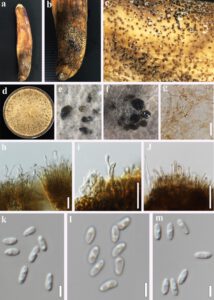Diaporthe vexans (Sacc. & P. Syd.) Gratz, Phytopathology 32, 542 (1942)
Index Fungorum number: IF 286070; Facesoffungi number: FoF 14120; Fig. 1
Associated with the fruit rot of Solanum melongena. Asexual morph: On PDA: Conidiomata pycnidial, globose to subglobose, multilocular, dark brownish to black, erumpent or immersed, often with brown to dark brownish exudate from the ostioles. Conidiophores hyaline in the upper region, rarely branched, pale brown to greenish at the base, smooth, 2–4-septate, tapering towards the apex. Conidiogenous cells 10–18 × 2–3 µm, phialidic, slightly tapering towards the apex. Alpha conidia 5–7 × 2–3 µm (x̅ = 6.6 × 2.9 µm, n = 30), hyaline, fusiform or oval, usually biguttulate. Sexual morph: Undetermined.
Culture characters – Cultures incubated on PDA at 25 °C in darkness, Colony pale yellowish, greenish to brownish at the centre, reverse pale yellowish, becoming brownish at the centre with age. Aerial mycelium yellowish, sparse, and fluffy, with irregular margin and visible conidiomata at maturity.
Material examined – Thailand, Chiang Rai Province, Fah Thai market, on fruit rot of Solanum melongena, 1 February 2023, K. C. Mallikarathna, EP03 (MFLU 23-0081), living culture MFLUCC 23-0076.
Known distribution (based on molecular data) – worldwide (Gratz 2006, Mahadevakumar & Janardhana 2016, Keinath et al. 2021, Farr & Rossman 2023), Thailand (this study).
Known hosts (based on molecular data) – species of Solanaceae are the main hosts (Gratz 2006, Mahadevakumar & Janardhana 2016, Keinath et al. 2021, Farr & Rossman 2023), Solanum melongena (this study).
GenBank accession numbers – ITS: OR131267, β-tubulin: OR162309, cal: OR162310.
Note – Diaporthe vexans, associated with the diseases of eggplants and brenjal (Solanaceae), is a serious fungal pathogen causing significant economic losses in terms of production around the world (Mahadevakumar & Janardhana 2016, Keinath et al. 2021). This species produces different disease symptoms, such as damping-off, leaf blight, fruit rot, and stem blight on the brinjal crop (Mahadevakumar & Janardhana 2016). Initially, brown, soft, sunken lesions appear on fruits. With disease progression, these lesions enlarge and merge, covering a larger portion of the fruit surface with concentric rings of small black pycnidia on the margins (Keinath et al. 2021). Pycnidia on fruits were commonly observed, and in severe infection with dry weather conditions, the infected fruit becomes shrivelled, dry, and mummified (Pawar & Patel 1957, Plantix 2023). Based on morphology and phylogenetic analyses, we identified the fungus we isolated from the fruit rot of eggplant as Diaporther vexans (Fig. 1). Hence, herein we provide the first report of D. vexans associated with eggplant fruit rot in Thailand.

Fig. 1– Diaporthe vexans (MFLU 23-0081, a new host record). a–c Conidiomata on the fruit. d–f Sporulating conidiomata on PDA. g Mycelia on PDA. h–j Conidiogenous cells. k–m Alpha conidia. Scale bars: g = 50 μm, h–j = 10 μm, k–m = 5 μm.
